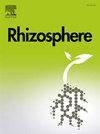硝酸盐高于铵:无论施肥处理如何,小麦和杂草之间的无机氮生态位分配有限
IF 3.5
3区 生物学
Q1 PLANT SCIENCES
引用次数: 0
摘要
施肥是影响生物地球化学循环和生态系统功能的重要农业实践,在小麦和杂草广泛共存的过程中发挥着核心作用。然而,小麦和杂草如何在氮有限的条件下共存,以及施氮肥后植物对氮的吸收策略如何变化,目前仍不清楚。我们选择了小麦(Triticum aestivum L.)和两种杂草(野燕麦(Avena fatua)和稗草(Echinochloa crusgalli))作为目标植物物种。我们将它们单独种植,约 7 个月后,用 15NH4Cl 或 15KNO3 标记这些植物 2 小时,以量化它们对 NH4+ 和 NO3- 的吸收,并测量根长、根面积、比根长、比根面积、比根体积和根组织密度。我们发现,施肥会导致小麦对资源养分的获取性状更强(即比根面积和比根体积增加(P <0.05)),而不会改变杂草的根系性状。在三个物种中,施肥后 NH4+ 和 NO3- 吸收量的增加不是由根系性状介导的,而是由施肥的直接效应引起的。此外,无论施肥与否,小麦和杂草都主要偏好 NO3- 而非 NH4+,这表明小麦-杂草共生的生态位分化有限。这些发现有助于我们更好地理解农业系统中物种共存的机制,尤其是作物和杂草对氮的吸收策略。本文章由计算机程序翻译,如有差异,请以英文原文为准。
Nitrate Over Ammonium: Limited inorganic N niche partitioning between wheat and weeds regardless of fertilization treatment
Fertilization is a crucial agricultural practice that influences biogeochemical cycles and ecosystem functions, and it plays a central role in widespread wheat and weed coexistence. However, it remains unclear how wheat and weeds coexist under N-limited conditions and how plant N uptake strategy change after N fertilization. Wheat (Triticum aestivum L.), and two weeds (wild oats (Avena fatua), and barnyard grass (Echinochloa crusgalli)) were selected as targeted plant species. We grew them alone, and after about seven months, we labeled these plants with 15NH4Cl or 15KNO3 for 2 h to quantify their NH4+ and NO3− uptake, and measured root length, root area, specific root length, specific root area, specific root volume, and root tissue density. We found that fertilization led to a more resource-acquisitive nutrient acquisition traits in wheat (i.e., increased specific root area and specific root volume (P < 0.05)), without altering weed root traits. Across three species, the increased NH4+ and NO3− uptake after fertilization were not mediated by root traits, but by the direct effect of fertilization. Additionally, both wheat and weeds predominantly preferred NO3− than NH4+ regardless of fertilization or not, indicating a limited niche differentiation for wheat-weed coexistence. These findings can improve our understanding of the mechanisms of species coexistence in agricultural systems, particularly with regards to N uptake strategies among crops and weeds.
求助全文
通过发布文献求助,成功后即可免费获取论文全文。
去求助
来源期刊

Rhizosphere
Agricultural and Biological Sciences-Agronomy and Crop Science
CiteScore
5.70
自引率
8.10%
发文量
155
审稿时长
29 days
期刊介绍:
Rhizosphere aims to advance the frontier of our understanding of plant-soil interactions. Rhizosphere is a multidisciplinary journal that publishes research on the interactions between plant roots, soil organisms, nutrients, and water. Except carbon fixation by photosynthesis, plants obtain all other elements primarily from soil through roots.
We are beginning to understand how communications at the rhizosphere, with soil organisms and other plant species, affect root exudates and nutrient uptake. This rapidly evolving subject utilizes molecular biology and genomic tools, food web or community structure manipulations, high performance liquid chromatography, isotopic analysis, diverse spectroscopic analytics, tomography and other microscopy, complex statistical and modeling tools.
 求助内容:
求助内容: 应助结果提醒方式:
应助结果提醒方式:


